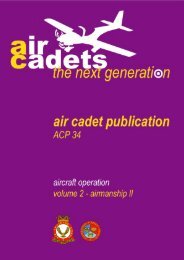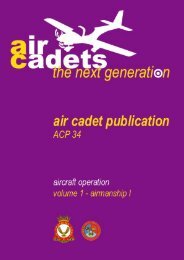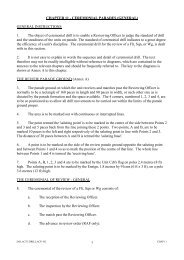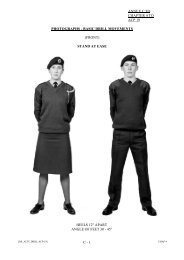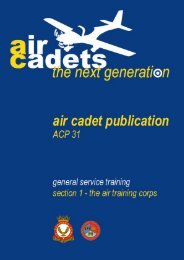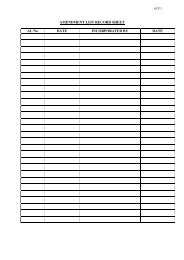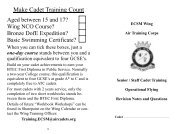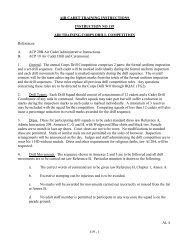Leading Cadet ECSM Wing Revision Guide - 967 Air Cadets
Leading Cadet ECSM Wing Revision Guide - 967 Air Cadets
Leading Cadet ECSM Wing Revision Guide - 967 Air Cadets
Create successful ePaper yourself
Turn your PDF publications into a flip-book with our unique Google optimized e-Paper software.
CHAPTER 3 PRACTICAL NAVIGATION<br />
If you know how fast you walk, you can work out<br />
how long it will take you to cover a known distance.<br />
For instance, a typical group will walk 1km over<br />
reasonably flat ground in 15 minutes, it would therefore<br />
take one hour to cover 4 km in similar terrain.<br />
Measuring distances accurately when hillwalking is<br />
important because it helps you calculate your speed<br />
of travel accurately.<br />
Naismith’s Rule<br />
A Scottish climber called Naismith devised a rule (in<br />
1892!) to calculate walking speeds over mountainous<br />
terrain.<br />
His basic rule assumed a walking speed of 4 km per<br />
hour over normal (flat) terrain.<br />
Climbing took more time, so he added 30 minutes for<br />
every 200m of climbing.<br />
Steep descents also need extra care and time, so he<br />
added 10 minutes for every 200m of steep descent.<br />
On expeditions you must take the group’s fitness<br />
into account, and also the fact that you will be carrying<br />
heavy packs.<br />
Pacing<br />
Distance can be measured by counting paces (or<br />
every other pace) and with practice this can be very<br />
accurate, but only over short distances.<br />
34<br />
Measuring distances accurately whilst hillwalking is important<br />
because it:<br />
a) Calculates your speed of travel.<br />
b) Keeps you on schedule.<br />
c) Chooses the shortest route.<br />
d) Pinpoints your position accurately.<br />
What do you estimate as the average walking speed of a<br />
group on level ground?<br />
a) 2 kph. b) 4 kph. c) 6 kph. d) 8 kph.<br />
A cadet is able to walk 1 km over reasonably flat ground in<br />
20 minutes. How long would it take him to cover 4.5 km in<br />
similar terrain?<br />
a) 40 mins. b) 60 mins. c) 90 mins. d) 120 mins.<br />
Whilst walking over reasonably flat ground, a cadet takes 1<br />
hour to cover 3 km. How long will it take him to walk 500 m<br />
at the same speed?<br />
a) 10 mins. b) 15 mins. c) 20 mins. d) 60 mins.<br />
What is Naismith’s rule?<br />
a) 3 kph overall.<br />
b) 5 kph overall.<br />
c) 5 kph plus an hour for any climbing.<br />
d) 4 kph as measured on the map plus half an hour for<br />
every 200m climbed.<br />
Naismith's Rule applies to the calculation of:<br />
a) Gradients.<br />
b) Shapes depicted by contour lines.<br />
c) Headings and bearings.<br />
d) The speed of advance on foot in mountainous country.<br />
How can you estimate distance covered from your last check<br />
point?<br />
a) Use your mobile phone.<br />
b) Use a pedometer.<br />
c) Consult your GPS.<br />
d) Measure the time taken and calculate at 4Km per hour.<br />
How much time should be added to a journey on foot for<br />
every 200 meters climbed using Naismith's Rules?<br />
a) 15 minutes. b) 20 minutes.<br />
c) 25 minutes. d) 30 minutes.<br />
How much time should be added to a journey on foot for<br />
every 200 meters of steep descent, using Naismith's Rules?<br />
a) 5 minutes. b) 10 minutes.<br />
c) 15 minutes. d) 20 minutes.<br />
Pacing can be an accurate way of measuring distances if<br />
carried out over:<br />
a) Long distances. b) Medium distances.<br />
c) Short distances. d) 5000 paces.<br />
CHAPTER 2 THRUST AND DRAG<br />
Besides lift and weight, two other forces act on an<br />
aircraft, thrust and drag.<br />
Thrust<br />
An aircraft’s engine, or engines, produce thrust to<br />
propel the aircraft forwards through the air. A<br />
propeller ‘screws’ air backwards, a jet engine<br />
expels air backwards at high speed. In both cases,<br />
pushing air backwards thrusts the aircraft forwards.<br />
(Newton’s Law again—every action has an<br />
equal and opposite reaction!) The thrust force acts<br />
along a line from the tail through the nose of the<br />
aircraft.<br />
Drag<br />
Drag is the force which hinders the aircraft’s<br />
progress through the air. Every part of the aircraft<br />
over which air flows produces drag which resists<br />
forward motion. ’Fairing off’ or streamlining can<br />
significantly reduce this. To simplify matters, we<br />
add all of these drag forces together and represent<br />
them with a single line (as we did with the lift<br />
forces). This line runs from the nose through the<br />
tail of the aircraft and directly opposes the thrust<br />
line.<br />
Variation of Drag with <strong>Air</strong>speed<br />
Drag varies (like lift) with the square of the airspeed.<br />
Doubling the airspeed gives four times the<br />
drag, trebling the airspeed, nine times the drag.<br />
Straight and Level Flight<br />
In steady (i.e. not speeding up, not slowing down)<br />
straight and level flight, just as lift must equal<br />
weight, so the thrust must equal the total drag.<br />
If thrust is greater than drag the aircraft will accelerate,<br />
if the drag exceeds the thrust the aircraft<br />
will slow down.<br />
Lift<br />
Thrust<br />
Weight<br />
Drag<br />
In steady straight and level flight, thrust opposes<br />
the drag and is equal to it, and lift opposes weight<br />
and is equal to it.<br />
7<br />
What is the force called that drives an aircraft forwards?<br />
a) Weight. b) Drag.<br />
c) Lift. d) Thrust<br />
The reaction to the rearward movement of air produced by<br />
the propeller or jet is called:<br />
a) Thrust. b) Drag.<br />
c) Resistance. d) Friction.<br />
The resistance to the forward movement of an aircraft is<br />
called:<br />
a) Drag. b) Resistance.<br />
c) Turbulence. d) Thrust.<br />
To accelerate an aircraft from straight and level flight,<br />
which of the following statements is true?<br />
a) Thrust must equal drag.<br />
b) Drag must exceed thrust<br />
c) Thrust must exceed drag.<br />
d) Drag must be half thrust.<br />
To slow an aircraft from straight and level flight, which of<br />
the following statements is true?<br />
a) Thrust must be less than drag.<br />
b) Thrust must equal total drag.<br />
c) Thrust must exceed total drag.<br />
d) Drag must be greater than thrust.<br />
Which part of an aircraft produces drag which resists<br />
forward motion?<br />
a) Every part of an aircraft over which air flows.<br />
b) The fuselage but not the wings.<br />
c) Only those parts which are producing lift.<br />
d) Only those parts of the aircraft that are not producing<br />
lift.<br />
If you doubled the airspeed the drag would increase by a<br />
factor of:<br />
a) 2 b) 4 c) 6 d) 8<br />
If you trebled the airspeed the drag would increase by a<br />
factor of:<br />
a) 3 b) 6 c) 9 d) 12<br />
A stream line shape with an airspeed of 100 kts has a drag<br />
force of 200 N (Newtons). If the airspeed were increased<br />
to 300 kts what would the drag be?<br />
a) 400 N b) 800 N c) 1800 N d) 3600 N<br />
Which of these statements about an aircraft in straight and<br />
level flight is true?<br />
a) Thrust is equal to the drag.<br />
b) Thrust is equal to twice the drag.<br />
c) Thrust is equal to half the drag.<br />
d) Thrust is equal to four times the drag.



